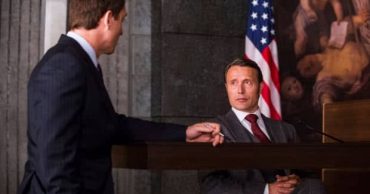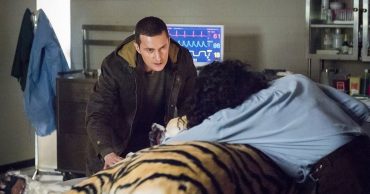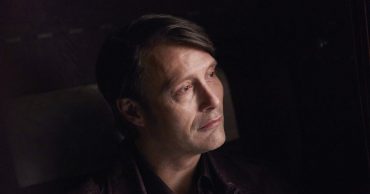
For those who had the misfortune of missing the first season of Hannibal last year (and there were many, based on the low ratings), NBC has done a huge service for television by giving Bryan Fuller at least thirteen more episodes of his prequel adaptation of Thomas Harris’ novel, Red Dragon. Not only was Hannibal the best new series in a year full of legitimate contenders for that title – its first run immediately situated the series alongside seasons of upper-echelon prestige dramas like Mad Men and Breaking Bad. The meticulous craft behind each and every scene in an episode of Hannibal is unparalleled, especially when compared to other broadcast network dramas. Each entry is an elaborate meal similar to the ones Dr. Hannibal Lecter arranges for his dinner guests. It takes an attentive and practiced palate to experience every nuance of what is being served, and even the most attentive and most practiced are likely still missing out on some things that Hannibal has to offer. Like any great piece of art, the amount of effort one puts into watching and experiencing something like this is proportional to the reward and satisfaction one receives. Over the next few months, I hope to impart what observations and analyses I can based on my own effort as we follow Hannibal, Will Graham and a host of other characters down what will certainly be a very dark rabbit hole this season.
The cold open to “Kaiseki” uses a familiar television trope – the flash forward. Twelve weeks from now, we will supposedly see this fight scene that takes place between Hannibal (Mads Mikkelsen) and Jack Crawford (Laurence Fishburne). We can speculate that the reason for the occurrence is that Will (Hugh Dancy) has finally convinced his boss not necessarily that he’s innocent but at least that Hannibal is guilty (it’s made clear several times in “Kaiseki” that Will is more concerned about being right regarding Hannibal than he is about convincing people of his own sanity). The plot details here don’t matter, though, and not only because it’s a projection of what’s to come weeks and weeks down the line. Instead, it serves as the perfect re-introduction to the world of Hannibal, which is as carefully constructed visually as it is narratively. Hannibal pushes one of his many kitchen knives down through some meat to the cutting board so that the camera can catch Jack’s face in the metal. We see all the concavities in both characters’ faces as their shifts in facial expressions preempt their attacks. The color palette is sharply defined, emphasizing a low glow. And as the fighting begins, the sound design and choreography take over in such startling ways that you have to hold your breath. The score in Hannibal isn’t so much music as it is noise created by a collection of instruments, mostly percussion in this sequence. All cylinders are firing, pushing the medium to its artistic threshold. These are practically crystalline sequences, and they’re not uncommon in Hannibal. What’s more, the visual cues often tie directly to the story being told; here, the kitchen setting is no coincidence, and the usage of the knives, cutting board and refrigerator door serve to illustrate that Jack has caught Hannibal in his natural setting and is seeing him at his most primal.
Then we cut to twelve weeks earlier, when the rest of the episode will take place and when Hannibal and Jack are mourning the “loss” of Will over Japanese cuisine. Hannibal points out that the style of the arrangement is meant to honor the taste and aesthetic of what they’re eating. So many lines in Hannibal carry this extra kind of weight and stand out ahead of ones like “I never feel guilty eating anything,” which Hannibal says shortly after and which is a more obvious wink to the audience. Why does Hannibal feel the need to honor the taste and aesthetic of the things he consumes? Does he honor Will in a similar way, having consumed him in a different fashion? It may be to better understand the things he eats, or it may even be a step further by allowing him to almost become that thing. This is his position regarding Will, in any case. “You’re the new Will Graham,” Agent Katz will tell him later in the episode before he gets to revel in helping profile a serial killer. And in that position, he certainly tries to honor Will’s perspective on death, seeing it through his eyes and aesthetic. Juxtaposed with that, we see Hannibal manifest in Will’s visions. So, while Hannibal tries to merge himself with Will through careful consumption, Will runs away from the Hannibal of his mind as quickly as possible. As soon as the horned devil version of Hannibal begins to rise up from where Will’s tackle has landed in the river of his daydreaming, we cut to the title sequence. Welcome back to Hannibal. This will not be easy to watch.
After a short scene where Jack and Alana Bloom (Caroline Dhavernas) are speaking with an investigator from the Inspector General, we’re introduced to the crime plot of “Kaiseki” that will almost be a safe haven from the psychologically taxing scenes detailing Will Graham’s current state. The killer in this instance is someone who injects his victims with silicon and BHT, a color preservative. His goal, Hannibal hypothesizes, is to create human models; the bodies that are found in the episode are merely the imperfect ones that were discarded. Last season’s premiere began with the Garrett Jacob Hobbs case that would serve as the season’s serialized plot. While this embalmer of bodies doesn’t seem to be a major player this season, the decision to leave the first case of the year unsolved is a smart one. Many of the early standalone cases last year fit comfortably within the tone and atmosphere of the series, but if the first half of that season had any flaw, it was that it moved too fast. Hannibal is at its most potent and horrifying when the pace is slowed down to a lethargic crawl. Instead of exploiting its violence for cheap thrills, Hannibal is what every serial killer series ought to be: deeply intelligent and artistic in its portrayal of violence. The bird’s-eye image of the bodies in the silo at the end of the episode, for instance, is horrific, but it’s executed in such a way that the imagery is astounding – the bodies align in a position that nearly looks like an eye. And more than any other series that I’ve ever seen – past or present – Hannibal takes the time to charter the effects that violence has on its characters (that’s precisely why Will is behind bars; if his job hadn’t got to him so completely, Hannibal wouldn’t have been able to manipulate him so easily). I’d also like to believe that the standalone plots of Hannibal somehow shed light on characteristics of Hannibal or Will or both. In this case, one could argue that Hannibal is a person looking for that perfect model to mold, which he found in Will. He tries to preserve that idea of Will as best as he can, but those impossible constructions decay eventually despite how hard Hannibal might try to prevent that.
Hannibal’s relationship with Will is undoubtedly the driving force of the series and this episode. He sits with his psychotherapist, Dr. Du Maurier (Gillian Anderson), trying to work through his feelings about Graham. “You are obsessed with Will Graham,” Du Maurier says. “I’m intrigued,” Hannibal replies. That is so often a fine line that is impossible to distinguish for the one(s) walking it. What is the end of the line for intrigue? Knowledge? Understanding? Hannibal seems to possess both of those where Will is concerned, so obsession looks like the more accurate definition. Obsession doesn’t end so abruptly. When you are intrigued by another person, that goes away with time and exposure. Obsession only gets stronger. Dr. Chilton (Raul Esparza) thinks of Will as obsessed with Hannibal, since that is all he talks about. This gravitational pull between obsessive personalities is undeniable, and one character feels incomplete without the other. There is a moment at the end of “Kaiseki” that fully encapsulates that – the image of Hannibal sitting in his office across from the empty chair that used to be occupied by Will in so many of their sessions. Though Will tells Hannibal that the light of friendship won’t find them for a million years, the two are permanently interconnected now. “He can’t repress who he is,” Hannibal says of Will. “There’s an honesty in that I admire.” As long as Hannibal sees himself in Will, he can’t help but be drawn in by him.
Three characters other than Hannibal visit Will: Katz, Crawford and Bloom. It is Alana’s whose visit winds up being the most important to the episode. When Will struggles to remember events he’s repressed or lost, Alana agrees to do some recall techniques. The metronome that’s used immediately recalls how Will rewinds the scene of a crime before reenacting it as the killer, which is a beautiful and respectful nod to the through-line of the art direction in this series. But as the recall begins, reality dissolves. Alana turns into dark specter hovering closer and closer to Will until her kiss engulfs him in the blackness of his mind. The scene that plays out is at Hannibal’s dinner table, where the devil version of him sits across the way. In front of Will, though, is a plate with Abigail’s ear. It’s grotesque and disturbing, but it’s exactly the way a memory like this might crop up in the far recesses of Will’s mind. He’s later amused by the paradoxical idea of a “new” memory, which I can imagine many long-term prisoners being able to relate to. That memory becomes more vivid when Will sits down to eat. He can see Hannibal shoving tubing down his throat and inserting the ear. At first, because of the plastic coat Hannibal is wearing, I thought it took place the night Will got an MRI towards the end of last season. But the setting is a domestic one, taking place – again – in a kitchen with visible pots and pans in the background. Regardless, it’s one step closer for Will in gathering some kind of evidence that he might be able to use – or at least a lead that Alana or Jack might be able to follow up on.
There’s plenty of other interesting things going on in “Kaiseki” (Chilton’s trip to Hannibal’s place is an unusual and amusing affair), but many of these threads are going to be pulled as the season progresses. So, too, will there be previous events that aren’t directly addressed here (where is Abigail’s body?) and a handful of new elements to disrupt the status quo (get ready for another huge addition to the cast in a familiar role for readers of Harris’ novels). Hannibal was one of the most unexpected surprises of 2013 – another serial killer series and specifically one about a character who had been written to cartoonish death in several films that managed to defy the very notion of skepticism. Again, this isn’t just a series that impresses in comparison to any demographic of which it’s a part. In the broad range of television series across all the channels and genres, Hannibal stands as a force to be reckoned with. Mikkelsen and Dancy are putting in two of the very best performances in any current television show. Bryan Fuller has found the perfect story through which to explore his own obsession – death. And every little peripheral part of crafting a television series that gets lumped into the “technical” umbrella term is held to incredibly high standards here. It would have been appropriate to come away from the first season of Hannibal thinking that it was lightning in a bottle – an anomaly impossible to replicate. I’m happy to say that “Kaiseki” captures every bit of that magic and then some.
[Photo via NBC]
 Follow Us
Follow Us





